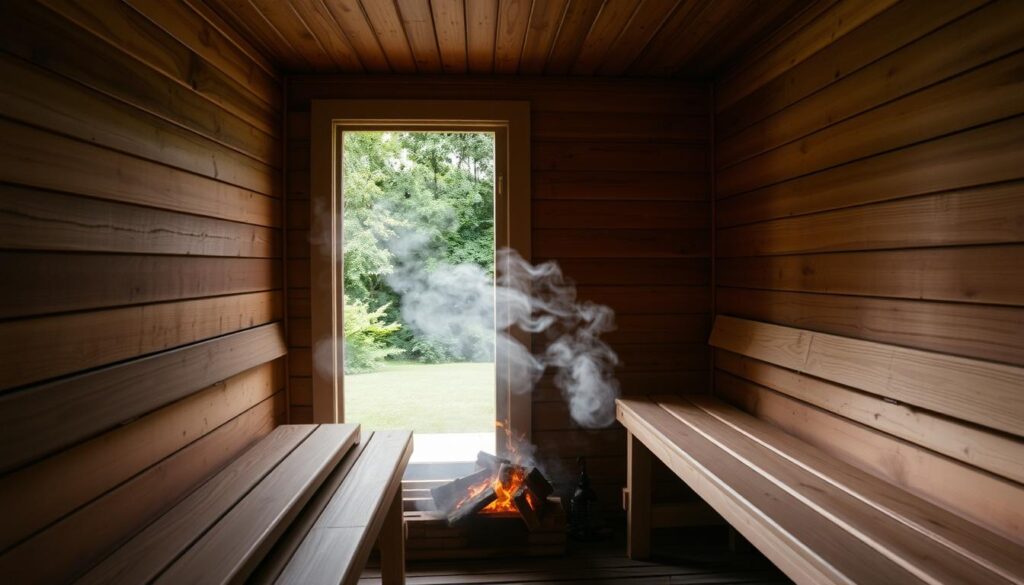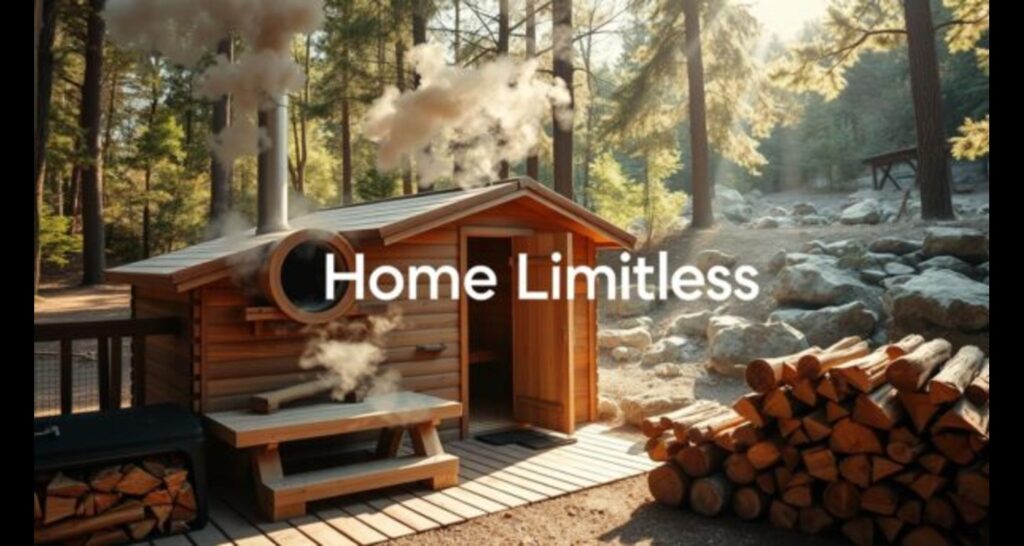Ever thought of using fire for ultimate relaxation? wood fired sauna mix tradition with comfort. But, they can be tricky for beginners. Let’s cover the basics to get you ready for your first session.
wood fired sauna are more than heated rooms. They’re a gateway to warmth and wellness. Reaching up to 200 degrees Fahrenheit, they beat electric saunas. The fire crackles, and wood scents fill the air, creating a unique experience.
For those who want flexibility, outdoor wood burning saunas are great. They’re perfect for places without electricity. The heat from wood stoves warms your body and soothes your soul.
Choosing the right wood is key. Hardwoods like oak, maple, and birch heat faster than softwoods. Keep the wood’s humidity below 20% for better burning. Fill the firebox 1/2 to 2/3 full and stir the coals every 5-10 minutes.
Heating times depend on the stove. A Harvia M3 stove heats to 110 degrees in an hour. A Huum stove takes about 100 minutes to reach 104 degrees. Quick door openings help keep the heat in. Aim for 140 degrees Fahrenheit for a traditional session, lasting 45-60 minutes.
Table of Contents
Key Takeaways
- Wood fired saunas can reach temperatures up to 200°F, hotter than electric saunas
- Use hardwoods with less than 20% humidity for efficient heating
- Fill the firebox 1/2 to 2/3 full and stir coals every 5-10 minutes
- Allow 45-60 minutes for the sauna to reach optimal temperature
- Drink 16-20 ounces of water before your session to stay hydrated
- Avoid alcohol and remove metal objects before entering the sauna
- Clean wooden interiors with mild detergent and keep surfaces dry
Introduction to Wood Fired Saunas
Wood fired saunas offer a unique and traditional sauna experience. They use wood burning stoves to heat rocks, creating a soothing atmosphere. Let’s explore the world of wood fired saunas and their benefits.
What is a wood fired sauna?
A wood fired sauna uses a wood burning stove to generate heat. These stoves can reach temperatures up to 200 degrees Fahrenheit. It takes 45-60 minutes to heat the sauna to 110 degrees Fahrenheit.
Benefits of wood burning saunas
Wood burning saunas offer many health benefits. They can reduce the risk of colds or flu by up to 30%. Regular use may also lower the risk of cardiovascular diseases.
The intense heat promotes a robust sweat. This helps to expel toxins more effectively than infrared saunas.
Traditional vs. modern wood fired saunas
Traditional wood fired saunas, dating back 2000 years, provide an authentic experience. Modern versions may have updated designs but still offer the traditional sauna experience. Both types require a chimney for ventilation and offer a unique, relaxing environment.
| Feature | Traditional Sauna | Modern Sauna |
|---|---|---|
| Heat Source | Wood burning stove | Wood burning stove or electric heater |
| Temperature Range | 160-195°F | 160-210°F |
| Heating Time | 45-60 minutes | 30-45 minutes |
| Wood Types | Cedar, Pine, Fir, Spruce | Cedar, Pine, Fir, Spruce |
Choosing the Right Wood Burning Sauna Stove
Finding the right wood burning sauna stove is key for a great sauna experience. The size of the sauna heater matters a lot. For small saunas up to 460 cubic feet, a compact stove like the Harvia M3 is good. It takes up 1.89 square feet and heats up to 190 degrees Fahrenheit.
Medium-sized saunas do well with stoves like the HUUM HIVE Wood. It heats up to 460 cubic feet and holds many stones for high temperatures. For bigger saunas, 350 to 700 cubic feet, you’ll need more powerful stoves like the Narvi NC series.
To find the right heater size, remember this rule: 1 kW of heater output per cubic meter of sauna room volume. Insulation and glass usage also matter. Each square meter of glass adds 1m³, and no insulation can increase the volume by 50%.
| Stove Model | Sauna Size (m³) | Max Temperature (°F) |
|---|---|---|
| Aito 16 | 8-16 | 210 |
| Aito 20 | 10-20 | 210 |
| Aito 24 | 12-24 | 210 |
Wood burning sauna stoves bring a special touch. They offer an immersive experience with crackling fires and glowing embers. These stoves can get up to 200 degrees Fahrenheit, hotter than electric heaters. They’re perfect for outdoor saunas, letting you place them anywhere without needing electricity.
Preparing Your Wood Fired Sauna
Getting your wood fired sauna ready is important for safety and fun. This part will show you how to prepare your sauna for use.
Selecting the Right Firewood
Choosing the right firewood is key for your sauna. Look for dry, seasoned wood with 15-20% moisture. Hardwoods like oak, maple, and birch give more heat and last longer than softwoods. Choose medium-sized logs that fit well in your stove.
Proper Sauna Room Ventilation
Good ventilation is crucial for your sauna. Make sure your chimney is clean and clear. Keep vents open to ensure good airflow. This helps keep the air quality high and the temperature right.

Safety Precautions
Safety is the most important thing when using a wood fired sauna. Always check your stove and chimney for damage. Use a fire-resistant mat under the stove. Keep flammable things away from heat. Use a thermometer to keep the temperature between 176-194°F for safety and comfort.
| Preparation Step | Key Points |
|---|---|
| Firewood Selection | Dry, seasoned wood (15-20% moisture) |
| Ventilation | Clean chimney, open vents |
| Safety Measures | Regular inspections, fire-resistant mat |
| Temperature Control | Install thermometer, aim for 176-194°F |
By following these steps, you’ll make your sauna safe, efficient, and fun. Remember, good preparation means a better sauna experience and longer equipment life.
Lighting and Maintaining the Fire
Learning to light and keep a fire right is key for a great wood burning sauna experience. First, clean the firebox. Get rid of ash and coals from before. This helps the fire burn better and cuts down on dust.
Next, fill the firebox about two-thirds with dry hardwood. Oak is a favorite because it burns long and hot. Place logs in different ways to help air flow.
Light the fire from the top, like modern fireplaces. Keep the damper open for 45-60 minutes to get the right temperature. Add wood every 10-15 minutes as needed. Stir the coals and wood to make the fire burn better.
Watch the stove’s temperature closely to avoid it getting too hot. The ideal temperature after an hour is 150 to 175 degrees Fahrenheit. Wood burning saunas can get up to 200 degrees, so you must be careful.
| Wood Type | Burning Properties | Recommended Use |
|---|---|---|
| Oak | Long-lasting, hot-burning | Ideal for extended sauna sessions |
| Birch | Clean burn, pleasant aroma | Good for regular use |
| Maple | Steady heat, minimal smoke | Suitable for beginners |
After your sauna, empty the ash box into a safe container. This keeps things safe and helps the fire burn better next time. Also, clean the chimney often to avoid soot and fire risks.
Wood Fired Sauna Temperature Control
Learning to control wood fired sauna temperature is crucial for a great sauna session. Wood-burning stoves can get up to 210°F, which is hotter than electric heaters. Most people prefer temperatures between 160-194°F.
Optimal Temperature Range
Beginners should start with lower temperatures and slowly increase them. Those who are more experienced like to have 15-20 minute sessions at higher temperatures. It’s best to wait 10 minutes after exercising before getting into the sauna to avoid getting too hot.
Using the Damper for Heat Regulation
To control the heat, adjust the firebox door. Open it to let more warmth in, and close it to reduce the fire. You can also fine-tune the heat by adjusting the ash pan opening. This method not only saves electricity but also adds a cozy, traditional feel to your sauna experience.
Adding Water for Steam (Löyly)
To create steam, add water to heated stones. Place the stones from largest at the bottom to smallest at the top for even heat and steam. This makes the sauna experience even better.

It takes about 30-60 minutes to get to the desired temperature. Regular upkeep will help your wood-burning sauna stove last longer.
Sauna Session Best Practices
A wood burning sauna session can be very relaxing and good for you if done right. Here are some key sauna tips to make your session better.
First, take a shower before going into the sauna. This cleans your skin. Then, go into the sauna when it’s at the right temperature, usually between 160º-180ºF. Start with short sessions of 10-15 minutes and increase the time as you get used to the heat.
It’s important to stay hydrated during your sauna session. You can lose up to 2% of your body’s fluids through sweat. So, drink water before, during, and after your sauna. Don’t drink alcohol because it can lower your blood pressure and make you feel dizzy.

Take breaks to cool down between sauna rounds. You can do this by taking a cool shower or sitting in a cooler area. This is like the traditional Finnish way of using sauna and cold water together, like swimming in icy water or taking a cool shower after sauna.
Listen to your body and leave the sauna if you feel too hot or uncomfortable. Finish your session with a cool-down and a shower to clean your skin and close your pores. The best health benefits from sauna come from regular use, ideally 4-7 times a week.
| Sauna Session Element | Recommendation |
|---|---|
| Temperature | 160º-180ºF |
| Session Duration | Start with 10-15 minutes, gradually increase |
| Frequency | 4-7 times per week for optimal health benefits |
| Hydration | Drink water before, during, and after |
| Cool Down | Take breaks between rounds, end with cool shower |
Cleaning and Maintaining Your Wood Fired Sauna
Wood burning sauna maintenance keeps your sauna in great condition. Regular care extends its life and ensures safety. Let’s explore important sauna care tips.
Post-session Maintenance
After each sauna session, follow these steps:
- Wipe down benches to remove moisture
- Leave doors open for drying
- Take a quick cold shower
Clean your sauna monthly with mild dish soap and warm water. For daily use, clean more often. Sauna cushions protect benches from stains and sweat, keeping your sauna clean and attractive.
Long-term Care for Your Sauna Stove
Proper sauna stove care is crucial for longevity. Remove ashes after each use and clean the firebox regularly. This ensures efficient burning in future sessions. Check the stove often for wear or damage. Clean sauna stones periodically and replace crumbling ones.
Chimney Maintenance
Clean your wood-fired sauna chimney at least once a year. Factors affecting cleaning frequency include sauna use and wood quality. Watch for dark stains on the chimney or smoke backing up into the sauna.
| Chimney Cleaning Steps | Tools Needed |
|---|---|
| Preparation | Safety gear (gloves, glasses, dust mask) |
| Clear out ash | Shop vacuum |
| Sweep chimney | Chimney brush, cleaning rods |
| Clean wood stove | Wire brush, scraper |
| Check for damage | Flashlight |
Remember, don’t paint or varnish your sauna’s interior. It can block wood humidity release and create toxic fumes. With proper care, your wood burning sauna will provide years of relaxation and health benefits.
Enhancing Your Wood Fired Sauna Experience
Make your wood burning sauna experience better with a few easy steps. Try adding essential oils like eucalyptus, lavender, or peppermint to the water. This not only relaxes you but also makes the atmosphere more calming.
Drink 16-20 ounces of water before you go into the sauna. This helps prevent dehydration and makes you feel more comfortable. For a more exciting experience, try contrast therapy. Switch between the sauna’s heat and a cold shower to improve blood flow and help muscles recover faster.
Try different breathing methods to get the most out of your sauna time. Techniques like natural breathing, box breathing, or the Wim Hof Method can increase lung capacity and lower stress. Always pay attention to how you feel. If you start to feel dizzy or uncomfortable, take a break to cool off.
- Use sauna accessories like hats, mittens, and towels for added comfort
- Practice mindfulness to embrace tranquility
- Consider post-workout sauna sessions for muscle recovery
By adding these elements, you can turn your wood burning sauna experience into a complete wellness ritual. Regular visits can boost your heart health, reduce stress, and improve your mood. Let the sauna’s warmth work its magic on your body and mind.
Conclusion
Wood fired saunas mix tradition and wellness, offering a real sauna experience that’s centuries old. They give off intense heat and a cozy feel, helping to reduce stress and boost heart health. The ritual of starting the fire and the smell of burning wood add to the experience.
Wood fired saunas need more work to get ready and keep up compared to electric ones. But they offer a deep, relaxing experience. They’re also cheaper in places with plenty of firewood and great for off-grid spots. Companies like ELU provide sauna wood stoves with a 5-year warranty, making it a good investment for your health.
Choosing between wood fired and electric saunas depends on what you like. Wood fired saunas are authentic, eco-friendly, and can save money. Electric saunas are easy to use and control the temperature well. Knowing the differences and following the right use can help you enjoy the wood fired sauna’s benefits. This way, you can make a sauna experience that’s just right for you and improves your health.








1 thought on “How to Use a Wood Fired Sauna: Tips for Beginners”